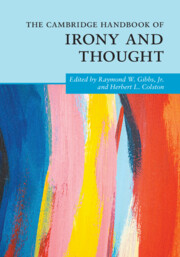Book contents
- The Cambridge Handbook of Irony and Thought
- Cambridge Handbooks in Psychology
- The Cambridge Handbook of Irony and Thought
- Copyright page
- Contents
- Contributors
- Part I Introduction
- Part II The Scope of Irony
- Part III Irony’s Impact
- Part IV Irony in Linguistic Communication
- Part V Irony, Affect, and Related Figures
- Part VI Irony in Expressive, Nonlinguistic Media
- 20 Ironies in Film
- 21 An Ear for Irony
- 22 Pictorial Irony and Sarcasm
- Index
- References
20 - Ironies in Film
from Part VI - Irony in Expressive, Nonlinguistic Media
Published online by Cambridge University Press: 20 December 2023
- The Cambridge Handbook of Irony and Thought
- Cambridge Handbooks in Psychology
- The Cambridge Handbook of Irony and Thought
- Copyright page
- Contents
- Contributors
- Part I Introduction
- Part II The Scope of Irony
- Part III Irony’s Impact
- Part IV Irony in Linguistic Communication
- Part V Irony, Affect, and Related Figures
- Part VI Irony in Expressive, Nonlinguistic Media
- 20 Ironies in Film
- 21 An Ear for Irony
- 22 Pictorial Irony and Sarcasm
- Index
- References
Summary
Films offer many interesting examples of irony in action. This chapter highlights the extent to which filmmakers create scenes that convey a range of both situational and verbal ironies. Films can express many types of irony (e.g., Charlie Chaplin films sometimes alerts viewers to ironic situations that the film character, Chaplin, is himself unaware of). Several of MacDowell’s arguments explicitly stand in contrast to Greg Currie’s claims that irony in film is rather limited. This chapter goes into many detailed examples of possible irony in films, including various cases of parody and dramatic irony, which greatly extend our understanding of the complexities of irony in both film and ordinary life. He later focuses on the larger, unresolved, question of whether films “contain” irony (i.e., as a property of films) or create conditions for viewers to infer their own ironic interpretations and experience particular emotional reactions (i.e., irony is an “effect” from films but not actually a property of films). MacDowell concludes that films offer viewers “invitations” to recognize an intended irony as being part of an artwork, even if that may not happen to all audiences.
- Type
- Chapter
- Information
- The Cambridge Handbook of Irony and Thought , pp. 367 - 384Publisher: Cambridge University PressPrint publication year: 2023



